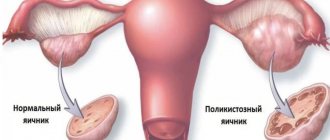Ovarian dysfunction is a violation of the functional activity of the ovaries, which is characterized by changes in hormonal levels. Ovarian dysfunction may result from inflammation or hormonal imbalance at the level of the hypothalamic-pituitary complex. All physiological mechanisms occurring in the ovaries are controlled by hormones that are produced in the hypothalamus and pituitary gland.
A change in the hormone-synthesizing function of the ovaries entails the development of many pathological conditions and a set of symptoms, such as anovulation (its absence) and changes in the nature of the menstrual cycle.
The duration of a normal menstrual cycle is 21-35 days, menstruation, on average, lasts from 3 to 7 days. The volume of blood loss during menstruation should not exceed 130 ml. Knowledge of the optimal indicators of menstruation makes it possible to note such deviations as lengthening or shortening of the cycle, changes in the duration of menstruation, the nature and volume of blood loss.
What is ovarian dysfunction
The content of the article
Ovarian dysfunction is a disruption of the functioning of organs caused by any health problem: an infectious-inflammatory process, stress on the nervous system, a disorder of the endocrine system. Since the ovaries are part of the body’s unified hormonal system, which also includes the hypothalamus, pituitary gland and adrenal glands, ovarian dysfunction can be both a cause and a consequence of disorders in other organs.
The problem is clearly visible to women, but often does not cause concern, since it is believed that irregular periods are a minor problem. Dysfunctional uterine bleeding (outside normal periods), as well as the PMS symptom complex (emotional instability, nervousness, nagging pain in the lower abdomen, etc.), are also attributed to any reason, including bad weather, but not to illness.
Unfortunately, the result of ovarian dysfunction is serious hormonal diseases: endometriosis, uterine fibroids, mastopathy, breast cancer, infertility. That is why it is important to respond to the first warning signs of pathology in a timely manner in order to protect yourself from serious consequences.
Causes and symptoms
The main cause of ovarian dysfunction is hormonal disorders. They, in turn, can be caused by the following factors: - sexually transmitted diseases; - inflammatory diseases of the genitourinary system; - endocrine disorders; — chronic fatigue and stress; — abortion or medical termination of pregnancy; - an incorrectly installed IUD in the uterine cavity; - as a result of taking medications, the side effect of which is menstrual irregularities. Symptoms of ovarian dysfunction: irregularities in the menstrual cycle, unplanned appearance of bloody discharge from the genital tract, pain in the abdomen. Abdominal pain with this disease in most cases is nagging in nature, but in some cases it can become acute and spread to the hips and lower back. The acute stage of ovarian dysfunction is characterized by severe cramping pain. If the disease has passed into a chronic stage, then the painful sensations become dull, and their strength increases with menstruation and physical stress. This condition is dangerous because there is a high risk of developing an abscess in the ovary. Subsequently, it can take on impressive dimensions. The other most common symptoms of ovarian dysfunction are PMS (lethargy, irritability, apathy), anemia (pale skin, increased heart rate, headache, drowsiness, weakness, decreased appetite, dizziness) and amenorrhea.
Symptoms of ovarian dysfunction
The work of the paired glands is regulated by hormones of the anterior pituitary gland, therefore the disruption of their work is based on regular failures of the hypothalamic-pituitary system. The pathology is characterized by the following symptoms:
- failure of the menstrual cycle: its excessive lengthening (more than 35 days) or shortening (less than 21 days), irregular menstruation;
- oligomenorrhea – excessive infrequency and scarcity of menstruation;
- polymenorrhea - frequent, prolonged (more than 7 days) and heavy menstruation (more than 150 ml).
Monthly heavy bleeding can lead to a drop in hemoglobin levels and, as a consequence, pale skin and mucous membranes, distortion of taste and smell, dry skin, and brittle nails.
Frequent symptoms:
- Problems with conception. With ovarian dysfunction, the process of egg maturation is disrupted, anovulatory cycles become more frequent, so fertilization cannot occur. If pregnancy does occur, then the likelihood of miscarriage increases.
- Bloody discharge that occurs between menstruation (lasting more than 3 days).
- Dysmenorrhea is pain during menstruation. In women, their general health worsens, their ability to work is impaired, nausea, headache, diarrhea, and pain in the lower abdomen of a pulling or cramping nature, radiating to the lower back, appear.
- A set of PMS symptoms: irritability, tearfulness, psychological changes, weakness, severe fatigue, apathy, etc.
- Amenorrhea is the absence of menstruation for more than 6 months. As a rule, this sign indicates the neglect of the pathology. This significantly increases the risk of cancer or heart disease. Women experience mental changes.
Reasons for the development of pathology
The normal functioning of the ovaries is ensured by the coordinated work of the adrenal glands, pituitary gland and hypothalamus. The functioning of organs is disrupted due to:
- Acquired and congenital endocrine disorders.
- Impact of external factors (changes in climate conditions, taking certain medications, etc.).
- Extragenital pathology.
- Overstrain, nervous exhaustion.
- Radiation therapy.
- Previous abortions, surgical interventions.
- Incorrectly installed intrauterine device.
- Inflammatory process in the appendages, uterus or ovaries due to a cold, improper douching, poor hygiene or hypothermia.
- Bad habits.
- Benign and malignant formations of the uterus and ovaries.
Options for the development of a dysfunctional state of the ovaries
The following types of ovarian dysfunction are distinguished:
- menstrual;
- anovulatory;
- ovulatory;
- hormonal.
Menstrual pathology is characterized by painful premenstrual syndrome and irregular menstruation.
Dysfunctional ovulatory bleeding occurs due to the lack of ovulation due to the body's excessive production of estrogen and insufficient progesterone levels. It is important for pregnant women to take into account the following fact: during the period when ovulation should occur, but does not occur, the pregnancy may be terminated.
Signs of this condition may be: irritability, sudden changes in blood pressure, weakness, weight changes, brittle nails, increased oiliness of the skin, dull hair, acne.
The possibility of ovulation occurring with ovulatory dysfunction is possible only by stimulating the ovaries with drugs.
The condition of anovulatory ovarian dysfunction is diagnosed by a gynecologist with repeated absence of ovulation. The duration of bleeding in combination with pain in the mammary glands may indicate an increase in estradiol in the body.
The conclusion about hormonal dysfunction of the ovaries is given on the basis of long-term disturbances of the monthly cycle. The symptoms are as follows: a week before the start of the next menstruation, a woman feels a nagging painful sensation in the lower abdomen; there are scanty or heavy bleeding; menstruation lasts longer than a week; In the intervals between menstruation, small spotting appears.
The main indicator for diagnosis is a delay or complete absence of menstruation. When critical days do not occur for more than six months, a serious disease such as amenorrhea develops.
Symptoms of ovarian dysfunction
Normal ovarian activity is regulated by follicle-stimulating (FSH) and luteinizing (LH) hormones and prolactin. The specific hormonal balance in each phase of menstruation ensures the normal functional state of the ovaries, which determines the onset of ovulation. Insufficient production of FSH and LH leads to an increase in the frequency of anovulatory cycles (without ovulation).
Ovarian dysfunction in women is characterized by the absence of the ovulatory phase and the corpus luteum phase. The condition is fraught with menstrual disorders due to excess estrogen and insufficient progesterone levels.
Signs indicating a malfunction of the ovaries are:
- changes in the nature, duration, volume of menstruation;
- the appearance of bleeding in the periods between menstruation;
- frequent dizziness;
- loss of appetite;
- severe pulling, dull or cramping pain in the lower abdomen, radiating to the lumbar and hip region;
- miscarriages;
- pale skin, increased temperature;
- sudden mood swings (weakness, apathy, joy);
- x facial coverings;
- impossibility of conception.
Each individual symptom should alert you and become an important reason to visit a gynecologist. Long-term lack of treatment is fraught with such dangerous complications as fibrocystic mastopathy, uterine fibroids, breast cancer, endometriosis, and infertility.
Acyclic bleeding can cause cancer. An ectopic pregnancy can be masked under a single menstruation failure.
Due to large blood losses during critical days, anemia develops. Hormonal imbalance causes a disruption in the body's absorption of calcium, leading to the development of bone osteoporosis.
Diagnosis of pathology
Making a diagnosis begins with diagnosis. First of all, a woman should visit a gynecologist. After an examination, the doctor may refer the patient for an ultrasound examination of the genital organs in order to exclude an ectopic pregnancy, or for a consultation with an endocrinologist. For medical reasons, both examinations may be prescribed. Next, the doctor gives a referral for tests and an ultrasound scan of the adrenal glands, thyroid gland, and kidneys. The list of laboratory tests also includes:
- General blood analysis.
- Vaginal smear for flora and oncocytology.
- Bacteriological culture of urine.
- Blood test for antibodies to sexually transmitted infections.
- Hormone analysis.
- X-ray, MRI of the brain.
Women who have previously been diagnosed with premature ovarian failure may additionally be prescribed an analysis to determine the concentration of estradiol in the blood.
Causes of ovarian dysfunction
Ovarian dysfunction can occur as a result of a serious illness or functional disorders. So, among the reasons for organ dysfunction are:
- Disorders at the hypothalamic-pituitary level;
- Inflammatory processes in the internal genital organs (uterus, ovaries, cervix): salpingitis, endometritis, oophoritis;
- Endocrine diseases - obesity, diabetes, diseases of the thyroid gland and adrenal glands. They cause hormonal imbalance, which ultimately affects reproductive function;
- Gynecological diseases such as endometriosis, adenomyosis, fibroids, ovarian and uterine tumors;
- Low immunity;
- Benign and malignant tumors of the internal genital organs;
- External factors: fasting, excessive thinness, prolonged stress, physical and mental fatigue, sleep disturbances, lack of rest, acclimatization, excessive sun exposure, taking certain medications, chemotherapy and radiation therapy;
- Error when installing the intrauterine device;
- Medical or spontaneous abortion. Termination of the first pregnancy is especially dangerous, since the body’s adjustment to bearing a fetus abruptly ends. As a result, persistent dysfunction occurs with the threat of infertility;
- Hereditary predisposition;
- Drinking alcohol, drugs, smoking.
Treatment regimen for amenorrhea
The doctor determines how to treat ovarian dysfunction based on studies conducted, during which the cause of the disorder should be identified. If it is a tumor or adenoma, then they resort to surgical removal. Treatment of amenorrhea with hormones is necessary to restore the interaction between the ovaries and the pituitary gland. Regardless of the cause, vitamins and physical therapy are prescribed as an addition to the main therapy.
Methods for treating amenorrhea without hormones are used if menstruation has disappeared due to sudden weight loss or intense physical activity. In such situations, it is enough to organize a nutritious diet, a proper work and rest schedule, and also normalize the psycho-emotional state.
Other treatment options:
- Taking hormonal contraceptives for polycystic ovary syndrome.
- Taking dopamine agonist drugs that lower prolactin – for hyperprolactinemia.
- Neurosurgical intervention for pituitary tumors.
- Hormone replacement therapy – for premature menopause.
As you can see, there can be many reasons for the development of amenorrhea, and without it it is impossible to select competent therapy. Therefore, in such a situation, you should never resort to self-medication. Amenorrhea is dangerous for the development of infertility, which in the future will be very difficult to cure, and sometimes even impossible. To receive qualified medical care, contact Dr. Akner. We employ professional gynecologists with extensive experience in the diagnosis and treatment of female diseases. Sign up for a consultation on the website or call us at 8 (926) 497-44-44.
Types of ovarian dysfunction
The following types of ovarian dysfunction are distinguished:
- Juvenile – manifests itself in girls 12-14 years old;
- Menopause – typical for women aged 45-55 years;
- Anovulatory – occurs due to disruption of the cerebral cortex and the hypothalamic-pituitary system;
- Ovarian wasting syndrome, or premature menopause. This pathological condition can occur in women under 40 years of age with a normal menstrual cycle and a history of childbearing. It is manifested by secondary amenorrhea, infertility and vegetative-vascular disorders;
- Resistant ovarian syndrome – characterized by the insensitivity of the ovaries to gonadotropic stimulation. It manifests itself as secondary amenorrhea and infertility in women under 35 years of age.
Juvenile pathology is associated with disorders in the hypothalamic-pituitary system. Menstrual irregularities, amenorrhea and acyclic uterine bleeding can be observed in girls within 2 years after menarche. They can be provoked by various factors: brain injury, meningitis, infectious and viral diseases (measles, rubella, tonsillitis, ARVI). As a rule, this type of disorder is transient and disappears after a few months or years.
Menopausal pathology occurs during involution of the reproductive system, i.e. this is a natural decline in the normal activity of the ovaries. This is evidenced by menopause - the unreasonable absence of menstruation for more than 6 months. Sometimes the pathology is provoked by hypertension, excess weight, obesity, diabetes mellitus, and central nervous system disorders. This condition is a favorable environment for the development of coronary heart disease and bone tissue destruction.
Menopausal ovarian dysfunction is manifested by a number of symptoms:
- profuse sweating;
- restless sleep;
- frequent urination;
- dry skin and mucous membranes of the vagina;
- hot flashes accompanied by redness of the skin;
- emotional instability.
- This age-related phenomenon is irreversible. However, you can get rid of unpleasant symptoms using hormone replacement therapy or alternative methods - taking bioidentical hormones, estrogen receptor modulators, phytohormones.
Classification
Since the term “ovarian dysfunction” is a collective concept, it includes the following conditions:
- hyperfunction;
- ovarian hypofunction;
- too active production of female sex hormones;
- too active production of androgens ;
- polycystic ovary syndrome;
- primary failure;
- unspecified dysfunction.
There is also a classification according to the patient’s age:
- juvenile – develops in adolescents immediately after the first menstruation;
- reproductive - develops in patients of reproductive age;
- menopause – diagnosed in the period before menopause and directly during menopause.
Diagnostics
A specialist gynecologist-endocrinologist examines and treats ovarian dysfunction. At the initial appointment, he identifies and evaluates the symptoms of pathology, taking into account information about heredity, life and obstetric history, and menstrual function. Then a gynecological examination is carried out with smears taken.
A set of diagnostic procedures is prescribed individually, which may include:
- Ultrasound of the pelvis;
- Ultrasound of the mammary glands;
- Ultrasound of the thyroid gland;
- Ultrasound of the adrenal glands;
- urine and blood analysis (general, biochemical);
- blood and urine test for hormones (LH, FSH, estrogens, progesterone, prolactin);
- microscopy and culture of secretions for vaginal microflora;
- PCR analysis for sexually transmitted infections (candidiasis, chlamydia, etc.);
- measurement of basal temperature (to determine the phase of the cycle in which there are disturbances);
- electrocardiography (to exclude cardiovascular pathology);
- blood test for adrenal and thyroid hormone levels;
- examination of the condition of the pituitary gland using skull x-rays, MRI and CT scans of the brain;
- electroencephalography to study the state of the brain;
- hysteroscopy with targeted biopsy of the cervix;
- diagnostic curettage of the uterine cavity and cervical canal for further histological examination of the scraping.
Diagnostic measures
By contacting the Clinical Hospital on Yauza, you will receive not only attentive, sensitive and sensitive attitude of the medical staff, but also a number of other advantages:
Consultation with the best specialists: our employees are engaged not only in medical practice, but also have extensive experience in scientific research and work in the best Russian and foreign clinics.
High-quality performance of the necessary tests: study of the level of sex hormones in the blood, the amount of thyroid hormones, diagnosis of metabolic disorders, determination of blood sugar levels are carried out in accordance with international standards and protocols for the treatment of the disease adopted in Russia.
High accuracy of examination: instrumental diagnostic methods - ultrasound examination of the adrenal glands, pelvic organs, thyroid and parathyroid glands, CT of the brain, MRI, radiography of the skull - are performed on modern computerized devices under the supervision of a physician.
Work for results: to develop an effective treatment regimen or select a method of surgical intervention, if necessary, a consultation with related specialists (endocrinologist, therapist, nutritionist) and additional studies (biopsy, hysteroscopy) are prescribed.
Make an appointment
Treatment
Treatment of ovarian dysfunction is always strictly individual. The main goals of therapy are:
- stopping life-threatening bleeding;
- eliminating the causes of pathology;
- restoration of the menstrual cycle.
For bleeding that threatens the patient's life (low hemoglobin level, unconsciousness or profuse bleeding), the following may be prescribed:
- separate curettage of the uterine mucosa for further histological analysis;
- symptomatic therapy (sometimes with elements of hormones) until bleeding completely stops;
- taking progesterone medications from days 16 to 25 of the cycle to prevent bleeding and restore cycle regularity;
- taking iron supplements to treat anemia;
- taking combined oral contraceptives to normalize the cycle (duration 3-6 months or more), if the woman does not plan to conceive. If pregnancy is planned, ovulation stimulation is prescribed.
After the bleeding stops, therapy is prescribed to eliminate the cause of the pathology. It may include the following procedures:
- antibacterial and anti-inflammatory therapy (if genital infections and inflammatory processes are detected), as a result of which, as a rule, the menstrual cycle and ovulation are restored independently, without hormone therapy;
- correction of identified diseases (diabetes mellitus, thyroid disease, etc.);
- normalization of lifestyle, work, rest and sleep patterns, avoidance of stressful situations, keeping the psycho-emotional state at rest, correction of diet and diet, vitamin therapy according to the phases of the cycle, homeopathic medicines and dietary supplements (if the “provocateur” of the pathology is external factors);
- for diagnosed gynecological diseases, treatment is prescribed individually (surgery, hormonal therapy);
- physiotherapy, reflexology;
- psychotherapeutic and psychological assistance.
Comment. For women with a history of ovarian dysfunction, insertion of an intrauterine device is contraindicated.
Ovarian dysfunction is a disease common to women of childbearing age. The first sign that there is some kind of disease in the female reproductive system is a disruption of the menstrual cycle. Ovarian dysfunction is dangerous because it can be a harbinger of various gynecological diseases and infertility.
The essence of the disease is ovarian dysfunction.
Quite often, women experience abnormal menstruation, that is, the cycle becomes either too short from two to three weeks, or too long - longer than thirty-five days.
Such menstruation can cause ovarian dysfunction.
The ovaries are one of the most important organs in the female reproductive system. The ovaries are located in the woman’s pelvis, their task in the female reproductive system is to produce female sex hormones - estrogens (to a greater extent), progestins and androgens to a lesser extent.
If the ovaries are working correctly, then menstruation “comes” regularly, the normal cycle is 21-35 days with a “bloody” period of three to seven days, ovulation occurs regularly. If menstruation is not regular, the menstrual cycle is disrupted, then a woman should think about ovarian dysfunction and not delay in contacting a professional gynecologist.
The disease ovarian dysfunction may not cause concern to a woman, but its consequences in the form of infertility, endometriosis, and oncology should force the woman to consult a specialist and undergo a course of treatment for this disease.
Symptoms of ovarian dysfunction.
What ovarian dysfunction is is clear. What are the symptoms of the disease:
- Irregular menstrual cycle.
- Scarcity or abundance of discharge during menstruation.
- Blood between cycles.
- Pain in the lower abdomen and lower back
- Poor health before the onset of menstruation - drowsiness, apathy, irritability, etc.
- Absence of menstruation for six months
- Severe pain during menstruation.
These symptoms can appear in a woman all at once or separately. The presence of any of these symptoms should be a reason for a woman to consult a gynecologist for help. Diagnosing ovarian dysfunction can lead to severe gynecological diseases - endometriosis, malignant tumors, ectopic pregnancy, infertility.
Why does ovarian dysfunction occur? Causes.
There are many reasons for the occurrence and development of ovarian dysfunction:
- inflammatory diseases, such as adnexitis, salpingoophoritis, oophoritis, endometritis, cervicitis
- uterine and ovarian diseases;
- endocrinological diseases;
- frequent worries, stress;
- overwork at work, intense mental work, lack of proper rest, poor nutrition, etc.
- abortions
- incorrect installation of the intrauterine device
- frequent use of solarium
- some medications.
Diagnosis of ovarian dysfunction.
The diagnosis of ovarian dysfunction can only be made after a thorough and correct examination.
As a rule, if a diagnosis of ovarian dysfunction is suspected, the patient undergoes an ultrasound of the pelvic organs, adrenal glands, thyroid gland, and tests (general blood count, general urinalysis). It is also necessary to undergo examination and be tested for sexually transmitted infections.
To exclude oncology, material should be taken for histology and biopsy.
Any other examinations and tests, including MRI, may also be prescribed, depending on the specific situation and the woman’s health condition.
Treatment of ovarian dysfunction.
Each course of treatment for ovarian dysfunction is purely individual, depending on the results of the examination. Treatment of ovarian dysfunction can be carried out on an outpatient or inpatient basis.
Treatment of ovarian dysfunction is purely individual and is prescribed by a gynecologist after examination.
As a rule, the following measures are taken to combat the disease:
- Emergency measures - stopping bleeding, raising hemoglobin, etc.
- Fighting the causes that led to the disease.
- Bringing the menstrual cycle back to normal.
- Regulation of hormonal levels.
No amateur activities in the treatment of ovarian dysfunction should be allowed, because A woman’s health and reproductive functions are at stake.
Is it possible to get pregnant if diagnosed with ovarian dysfunction?
A question that plagues many women faced with this disease.
Ovarian dysfunction is the main cause of infertility. If pregnancy does occur, it may end in miscarriage.
Also very often, ovarian dysfunction causes ectopic pregnancy.
A normal pregnancy with a diagnosis of ovarian dysfunction is very rare, but possible.
In any case, pregnancy if a woman has ovarian dysfunction can be planned only after the menstrual cycle has normalized.
Gynecologists at Only Clinic, having many years of experience and relying on the achievements of world medicine, individually develop a course of treatment for ovarian dysfunction for each patient.
Firstly, hormonal drugs are prescribed, which are selected individually. They are usually taken from days 5 to 9 of the cycle. Doctors constantly monitor the process of follicle maturation and regularly conduct ultrasounds for this.
If you follow all the recommendations of the gynecologist at the Only Clinic and do not lose hope, then the desired pregnancy will definitely come.
To make an appointment with gynecologists at the Only Clinic, call +7
Complications and consequences
A disorder of the hormonal function of the ovaries in the absence of timely treatment can lead to serious consequences. Without correction, the pathology leads to a persistent disruption of the woman’s hormonal status, the most likely outcome of which will be infertility or the inability to bear a child. The risk of serious diseases of the reproductive system also increases significantly, especially in women of premenopausal age (40-45 years):
- fibroids;
- mastopathy;
- endometriosis;
- uterine fibroids;
- cancer of the uterus;
- breast cancer.
During pregnancy
The question of whether it is possible to get pregnant with such a pathology interests many women. However, the doctor cannot immediately clearly answer the patient whether she will be able to get pregnant. It depends on the severity of the disease and the reasons that provoked it.
It is important that the process of preparing for pregnancy is controlled by a doctor, prescribing adequate therapy and monitoring the woman’s condition over time. If necessary, a course of treatment is carried out to restore ovulation.
If the doctor correctly approaches the determination of the treatment regimen, then modern methods of therapy help to get pregnant and carry the baby to term. It is important that from a very early stage the expectant mother is regularly examined by a specialist and advised on all issues. After all, women with such a pathology may experience critical periods throughout pregnancy, during which abdominal pain and discharge appear. Such symptoms should be reported to your doctor immediately.
If pregnancy does not occur even after treatment, it is advisable to consult a fertility specialist about the possibility of artificial insemination.
If a woman had a frozen pregnancy , after that she also needs medical supervision, since dysfunction after such a pregnancy can provoke very serious complications.
Probability of pregnancy
Ovarian dysfunction is not a death sentence for women who want to have a child. Pregnancy is possible, but only with medication support. Preparation and attitude towards it must be especially attentive.
The duration of treatment is about 6 months and is carried out under the close supervision of a gynecologist-endocrinologist. The woman is prescribed a course of hormonal therapy aimed at restoring the ovulatory menstrual cycle. When the mature follicle reaches 18 mm, and the thickness of the endometrium is 8-10 mm, the woman is injected with hCG, which provokes ovulation. Ovulation is monitored using ultrasound of the follicles, basal temperature measurements and blood tests.
According to statistics, therapy is successful for 90% of women and it is possible to achieve conception. Further pregnancy is carried out under careful supervision.
Treatment with folk remedies
Home remedies can be used in the treatment process as auxiliary methods. However, before doing this, you should definitely consult your doctor about this.
The most commonly used are infusions and decoctions of herbs, which take a long time to get the effect.
- Strawberry leaves . 1 tbsp. l. leaves pour 400 ml of water. After 6 hours, strain. Drink 1 tbsp every day. l. Similarly, you can prepare a healthy drink from raspberry leaves. These remedies are indicated for those who have heavy periods.
- Calendula . 10 g of dried flowers pour 200 ml of boiling water. Strain after 3 hours. Drink 2 tbsp. l. three times a day. The product helps regulate the monthly cycle.
- Viburnum bark . 1 tbsp. l. chopped bark, pour 250 ml of water and boil for 20 minutes. Add water so that you end up with the same amount of liquid as at the beginning. Drink 1 tbsp three times a day. l. The remedy is indicated for heavy bleeding.
- Red clover . Collect clover inflorescences, dry, 3 tbsp. l. Pour boiling water over this raw material and leave. Drink 2 tbsp. l. three times a day.
- Nettle . 1 tbsp. l. nettle pour 1 tbsp. boiling water, then boil for another 10 minutes. Drink this portion in small sips throughout the day. The product helps restore hemoglobin . However, it is important to consider that nettle increases blood clotting.
- Coltsfoot and sweet clover . Prepare a mixture of these herbs (10 parts coltsfoot and 1 part sweet clover), prepare an infusion by taking 1 tbsp. l. product in a glass of water and leave for 10 minutes. in a water bath. The product helps with heavy periods.
- Cinquefoil anseri . 20 g of the product should be poured into a tbsp. boiling water and cook for another 15 minutes. Cool, drink 4 r. 50 g per day before meals. The remedy is indicated for painful periods.
- Onion peel . Remove the skins from 1 kg of dry onion, pour in 2 tbsp. boiling water and cook for another 20 minutes. Drink half a glass in the morning after waking up. The remedy is indicated for scanty periods.
- Black radish juice . Grate the radish and squeeze out the juice. Add 1 tbsp to it. l. honey, stir. Drink 2 tbsp. l. before meals 4 times a day.
- Borovaya uterus . A decoction is prepared from 100 g of herb and 1.5 glasses of water. Boil the product for half an hour, drink 4 times a day, 1 tsp.
- Water pepper . 1 tbsp. l. herbs pour 1 tbsp. boiling water, leave. Drink 1 tbsp. l. three times a day. The infusion helps reduce blood loss during heavy periods and reduce the severity of pain.
- Ruta . Pour 5 g of rue leaves into 150 g of boiling water and cook for 15 minutes. so that the product does not boil, but simmers. Strain and drink the entire dose in the morning after waking up, then do not eat for 5 hours. Take the product once during scanty periods.
- Horsetail . 1 tsp. herbs pour 1 tbsp. boiling water Infuse and drink 1 tbsp. l. three times a day. Recommended for painful and heavy periods.
- Blueberry branches . This product is used for douching. 1 tbsp. l. means pour Art. boiling water and leave for 30 minutes. Before douching, dilute the infusion with water.
For various disorders of the monthly cycle, it is also recommended to use herbal teas:
- First collection . Mix equal parts of birch leaves, mint, blackberry, yarrow herb, buckthorn bark, take 1 tbsp. l. means and pour boiling water (1 tbsp.). Strain and drink throughout the day. Take 3 months, the course can be repeated after 2 months. Indicated for irregular periods and pain.
- Second collection . Mix equal parts of buckthorn bark, lemon balm leaves, valerian root and cinquefoil herb, take 1 tbsp. l. product and pour 200 ml of boiling water over it. Strain after a few hours, drink a glass of the product 3 times a day for 5 days. Start treatment a few days before your period and stop on the first day.
- Third collection . Mix 2 tbsp. l. sweet clover, meadowsweet, meadowsweet, calendula, string, brew 1 tbsp. l. means Art. boiling water Drink the resulting infusion in the morning and evening. Start taking it on the last day of your period and continue treatment until the next one.
- The fourth gathering . Take 1 part wormwood, 3 parts oregano and lovage, 4 tbsp. l. garden quinoa. Stir, 3 tbsp. l. collection, pour 1 liter of boiling water. Take 100 g 6 times a day. Indicated for scanty periods.
- Fifth collection . Take 1 part each of fennel and juniper fruits, rue herb, St. John's wort, and cinquefoil; 2 parts each of parsley root, parsley seeds, rose hips, wormwood herb. Pour 2 tbsp. l. means 400 ml boiling water. After infusion, drink 100 ml twice a day. Take for 2 months. with scanty periods.
Prevention
To prevent the occurrence of a disorder of the hormonal function of the ovaries, it is necessary to follow simple precautions:
- compliance with personal hygiene rules;
- regular visits to the gynecologist (2 times a year);
- timely treatment of genital diseases;
- healthy lifestyle, nutritious nutrition;
- psycho-emotional stability, elimination of stress and anxiety;
- proper use of hormonal medications;
- refusal of artificial termination of pregnancy;
- moderate physical activity;
- maintaining body weight control;
- protection from strong and frequent sun exposure;
- prevention and timely treatment of endocrine diseases;
- avoiding hypothermia;
- rejection of bad habits.
Progress of treatment
Ovarian dysfunction is treated comprehensively and consists of several stages. First of all, emergency treatment is carried out, if any: stopping bleeding and correcting anemia. The next step is to eliminate the causes of the development of disorders and restore hormonal levels with a normal menstrual cycle: treatment of concomitant pathologies, rehabilitation of foci of infection, hormonal replacement correction. For treatment to be effective, it is recommended to maintain proper nutrition, moderate physical activity, healthy sleep, and give up bad habits. In some cases, you may need the help of a psychologist or psychotherapist.








